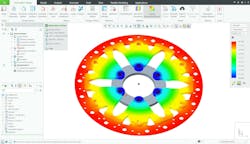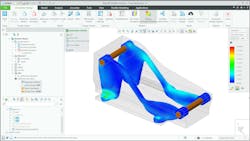AI-Powered Generative Design: A New Era of Product Innovation
Key Highlights:
- AI-driven generative design automates the exploration of thousands of design permutations, significantly reducing development cycles and costs.
- Integration of simulation and manufacturing constraints ensures designs are optimized for real-world production, minimizing redesigns and delays.
- Cloud-based tools like Creo GDX enable simultaneous evaluation of multiple design scenarios, accelerating decision-making and innovation.
Enjoying Machine Design’s Industrial Equipment & Heavy Machinery content? Be sure to check out the rest of our Takeover Week coverage here.
Tools driven by artificial intelligence (AI), such as generative design, are reshaping product development by automating and optimizing solutions that once required extensive manual iteration. Engineers define parameters—materials, loads, manufacturing methods and performance targets—and advanced algorithms rapidly evaluate thousands of design permutations. The result uncovers optimal, innovative and often unexpected solutions delivered in a fraction of the time.
Traditional design is often limited by tight timelines and budgets, restricting exploration to a narrow set of options. Generative design removes this constraint by rapidly generating and evaluating countless alternatives, accelerating development and enabling breakthroughs well beyond even the most efficient manual methods.
With these advantages, generative design is gaining traction and is poised to become a staple of product development. According to KBV Research, the Global Generative Design Market size is expected to reach $938.9 million by 2031, rising at a market growth of 19.8% CAGR during the forecast period. As AI continues to evolve, particularly in synthesizing simulation data, physical testing results and real-world usage insights, generative design is moving from a niche tool to a core capability in digital product development.
What is Generative Design?
Unlike topology optimization, which improves existing geometry, generative design starts from a clean slate, opening possibilities that are free from historical design limitations or human bias. Building on the foundations of topology optimization, generative design not only enhances performance, reduces weight and meets structural goals, it also changes how engineers work and collaborate.
READ MORE: Precision Meets Process: MBSE and Laser Metrology Aid in Complex Assembly
Mark Fischer, product manager for PTC’s Creo, explains that while it incorporates these traditional benefits, generative design integrates simulation and manufacturability requirements from the start. The resulting designs are not only optimized but ready for production.
“Generative design delivers more than optimized geometry; it enables a digital transformation across the enterprise,” he said. “This allows manufacturers to drive productivity by addressing workforce skill gaps as entry-level engineers can quickly generate innovative, high-quality designs that meet specific criteria. In short, the solution is democratizing the next generation of design by eliminating carryover geometry and reducing the reliance on deep engineering experience.”
The Role of AI in Generative Design
At the heart of generative design is AI, which intelligently explores and refines designs through iterative simulation, often using finite element analysis (FEA) or real-world performance data. In more advanced implementations, AI can consider a mix of functional, structural and aesthetic parameters while also respecting physical and manufacturing constraints.
For example, some systems now generate solutions that are not only structurally sound but also optimized for specific processes like extrusion, casting, additive manufacturing or traditional CNC machining. This ensures the output is both high-performing and immediately manufacturable, removing a common bottleneck between design and production.
Fischer noted that PTC’s Generative Topology Optimization (GTO) leverages AI to automatically generate optimal designs that address performance objectives, material usage, loads and production requirements.
“After engineers input functional requirements, the software generates a range of valid design options that meet those needs,” he said. “This enables rapid iteration and deeper exploration of trade-offs between multiple performance goals, such as strength, cost, weight and manufacturability. The process transforms design from a linear workflow into a strategic, data-rich tool that promotes both innovation and efficiency.”
Transforming Engineering Workflows
Generative design isn’t just a modeling tool; it reshapes how teams work across the entire product development lifecycle.
“The integration of simulation directly into the generative workflow means each design is validated as it's created,” Fischer said. “This significantly reduces the need for separate analyses and iterations. Designers are no longer forced to move between tools to test options; simulations and optimizations run in parallel, automatically.”
Benefits include:
- Accelerated development. Generative design reduces design cycle times dramatically. By some estimates this can speed time to market by up to 70%.
- Material and weight efficiency. AI-optimized components are often up to 40% lighter while still maintaining structural integrity and meeting safety requirements.
- Cost reduction. By reducing overengineering and limiting the need for physical prototypes, organizations have reported cost savings of 20% to 50%.
- Increased innovation. AI explores a wider range of solutions than humans can alone, often discovering breakthrough geometries or previously overlooked trade-offs.
- Sustainability gains. Generative design supports environmental goals by reducing material waste, energy use and emissions across the lifecycle.
An AI-Driven Design Environment
Integrated Simulation
Throughout the optimization process, PTC Creo automatically performs structural, thermal and load-bearing analyses to validate each design iteration. This ensures that all generated options are not only aligned with defined objectives but also validated against real-world conditions. Engineers can evaluate trade-offs—such as durability vs. weight—within a unified environment—eliminating the need for external tools or validations.
With seamless Creo integration, generated parts remain fully editable within the Creo environment, retaining parametric history and supporting continued refinement. Engineers can run additional simulations, apply documentation, and finalize designs, all without leaving the platform. This seamless integration eliminates the inefficiencies of importing/exporting models and preserves a traceable digital thread across the entire workflow.
Manufacturing-Aware Designs
Creo generative design prioritizes manufacturability alongside performance. The software incorporates manufacturing constraints, whether for additive or subtractive methods, directly into the design process. This ensures that output is production-ready by default, reducing downstream redesigns and enabling a smoother transition from digital model to physical product.
Complete cloud-based connectivity allows PTC’s generative design capabilities to extend to its suite of cloud and desktop platforms (Creo, Windchill), offering flexible, enterprise-ready tools for AI-powered design.
READ MORE: SaaS: The Concept of a Single Source of Truth
The generative design extension (GDX) takes Creo’s generative topology optimization (GTO) to the next level. With GTO, engineers were able to explore one design at a time, setting up a single combination of materials, loads and manufacturing methods to find the best shape for that scenario. GDX allows designers to explore multiple possibilities at once.
Instead of running one study after another, engineers can define several materials and manufacturing methods together (like aluminum vs. steel, or additive vs. machined), and GDX uses powerful cloud computing to generate and compare all the options in parallel. The best designs rise to the top automatically, giving you a range of ready-to-manufacture choices that can be reviewed and refined right inside Creo.
PTC also offers Windchill for enterprise integration. Windchill enhances generative design with data governance and AI-driven insights, helping teams identify compliance issues, support design reuse and improve supply chain visibility ensuring that designs meet both technical and strategic goals.
These platforms create a cloud-connected ecosystem that integrates generative design with enterprise workflows from concept to production.
Impact Across Industries
Across aerospace, automotive, consumer goods, medical devices and industrial equipment, companies are realizing tangible benefits from generative design. For aerospace and automotive, where weight savings translate directly into fuel and cost efficiency, generative design delivers both structural improvements and manufacturing feasibility. Tools like Creo GDX make it possible to achieve these gains while simplifying production.
The Future of Generative Design
Generative design is entering a new era, one where intelligence, integration and automation redefine how products are conceived and refined. As artificial intelligence, cloud computing and connected product ecosystems continue to mature, generative tools are evolving from design accelerators into strategic collaborators that learn, adapt and guide the engineering process in real-time.
In the near term, expect to see PTC Creo’s GDX and related tools become increasingly connected across the PTC digital thread, linking simulation, PLM, manufacturing and cloud collaboration into a seamless, digital environment. These integrations will allow design intent, performance insights and production feedback to circulate continuously, giving engineers an unprecedented level of context and confidence in every decision.
READ MORE: How AI-Driven, Cloud-based CAD Supports Efficient Product Design
As AI capabilities expand, generative design will become predictive and prescriptive—not just exploratory—helping teams anticipate design challenges, optimize for multiple business goals and accelerate time-to-market. Engineers will gain deeper insight with fewer late-stage changes, designers will enjoy greater creative freedom within validated constraints, and managers will see tighter alignment between innovation, manufacturability and profitability.
PTC’s vision is to make generative design an everyday partner in the engineering workflow, intelligent, connected and continuously learning to become even more practical.
Generative design is redefining product development, from creative concepts to final production. PTC aims to make this transformation real, enabling faster development, greater innovation and more sustainable outcomes. Generative design isn’t just a tool for the future; it’s the new standard for competitive product development.


